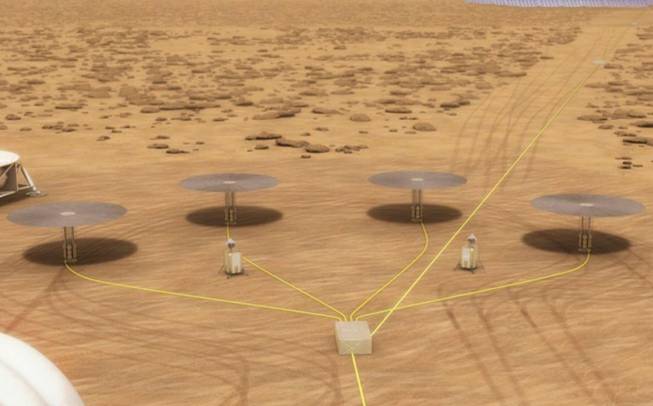
NASA
An artist’s rendering of what a Kilopower fission power system could look like on the surface of Mars.
Thursday, Jan. 18, 2018 | 2:38 p.m.
As NASA looks to advance human missions to space in the coming decades, developing safe, reliable power sources to carry out those excursions is a top priority.
Looking for a way to supplement radioisotope power systems that use naturally decaying plutonium-238, NASA officials discussed the Nuclear Systems Kilopower Project today at the National Atomic Testing Museum in Las Vegas.
Fission power from nuclear reactors could provide the energy needed anywhere humans or robotic science probes might be deployed in space, including Mars.
“I believe we are not at a breakpoint in terms of having the capability to allow crews to survive and flourish on planetary surfaces,” said Lee Mason, NASA’s chief principal technologist for power and energy storage.
Fission is the splitting of an atom’s nucleus, releasing a large amount of heat energy. A pound of uranium fuel can produce as much energy as about 3 million pounds of burnable coal.
In 2012, Los Alamos National Laboratory in New Mexico and NASA Glenn Research Center in Ohio demonstrated how a small fission reactor could provide electrical power, creating the basis for the $20 million Kilopower project, which launched in 2015.
The goal was to develop and test a prototype of a space fission power system. Testing of the Kilopower reactor started in November at the Nevada National Security Site, about 80 miles northwest of Las Vegas, and is set to wrap up in March.
“Located in a remote, high-security area of Southern Nevada, we’re ideally suited to conduct unique experiments in our indoor, outdoor and underground national facilities,” said Mark Martinez, president of Mission Support and Test Services, the managing and operating contractor for the test site.
Fission power systems present an ideal solution for space missions that require large amounts of power, especially where solar energy is limited or not available.
Mars, for instance, gets limited sunlight — less than half of that on Earth — and is subject to dust storms that can last for months.
“Mars isn’t a very hospitable place,” Mason said. “Some of the challenges on Mars, which are significant, make nuclear power a viable option.”
Safety of the reactor is a priority, officials said.
“This reactor won’t be turned on until it’s deep into space,” Said Patrick McClure, Kilopower project lead at Los Alamos. “On launch, if we were to have something like an explosion, the risk to the public would be very minimal.”
The power system would be launched into space and assembled in orbit before touching down someplace like Mars. The reactor towers are about the size of an average person and resemble umbrellas.
But any such trip to Mars or beyond is years away, as it will take a couple of decades to develop the required systems and technologies.
“Our plan it to do a crude orbital mission of Mars — so just the transportation portion — in the early 2030s,” said Steve Jurczyk, NASA’s associate administrator for space technology. Putting Kilopower reactors on the surface wouldn’t happen until the later 2030s, he said.
